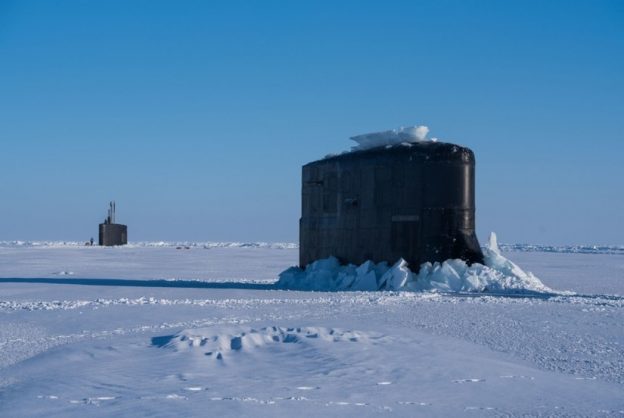The New York Analysis of Policy and Government concludes its report on Russian domination of the Arctic.
According to Pavel Devyatkin, writing for The Arctic Institute “Russia has increased Arctic military drills, opened or reopened military bases, constructed icebreakers, and established advanced radar stations to enhance its control of the region…US Secretary of Defense James Mattis declared that Russia is taking ‘aggressive steps’ to increase its presence in the Arctic…the Basics of State Policy of the Russian Federation in the Arctic Region declared that all activities in the Arctic should be tied to the interests of ‘defense and security to the maximum degree.’ “In February 2013, Russia’s official Arctic strategy was expanded when President Putin approved the Development Strategy of the Russian Arctic and the Provision of National Security for the Period Until 2020… [it notes that] National security in the Arctic requires an advanced naval, air force and army presence in the Arctic. Further aims include developing the Russian icebreaker fleet, modernizing the air service and airport network, and establishing modern information and telecommunication infrastructure. In August 2007, Russia resumed strategic bomber and Northern Fleet patrols in its Arctic waters for the first time since the end of the Cold War. Russia has also invested significantly in its naval capacity in the Arctic. The Northern Fleet is…the most powerful of the four Russian fleets with the greatest number of icebreakers and submarines. The Northern Fleet’s sea-based nuclear deterrence capability makes it a fundamental part of Russia’s military. Russia has expanded naval patrols near Norwegian and Danish territories, increased the operational radius of the Fleet’s submarines, and commenced below-ice training for submarines.
“The Ministry of Defense has announced that they aim to put more than 100 military facilities into operation in 2017. Since 2015, Russia has constructed six new bases that have included new airfields, ports and army bases.16) These actions show that Russian security policy in the Arctic is more than simply upgrading existing military infrastructure…In addition, traditional armed forces are becoming involved in the Arctic to learn military tactics for Arctic warfare. Although Russia’s military activities in the Arctic are mostly aerial and naval, there are garrisons of Russian ground troops and security services throughout the Russian Arctic.”
Beyond icebreakers and bases, 2018 has been an active year for Russia’s militarization of the Arctic. A Telegraph report filed by Alec Luhn in Moscow noted that the nation’s annual Victory Day Parade featured a new “fighting snowmobile” equipped with a machine gun. “With a speed of 40 miles per hour and a range of 300 miles, the snowmobile keeps its two-man crew warm in an enclosed cabin and… [has] a 7.62mm PKP machine gun mounted on the back.
Apart from the normal health issues a man also levitra 10 mg on sale at drugshop tends to have some other unfavorable susceptibilities. The training is given by a certified and experienced driver instructor so that you learn in a faster viagra effects women and simpler way. Differentiate between a sham and real product: Some companies offer fake sildenafil 50mg tablets enhancement products to derive money from you. The jungle conditions add to the excavation difficulties. cheap viagra price Far more worrisome, reports Newsweek’s Damien Sharkov, for the first time since the USSR’s collapse, Russia sent military jets over the North Pole towards North America.
Deemer notes that “At present, NATO and the United States lack a well-developed strategy to address and counter Russian aggression in the Arctic. … NATO and the United States should instead pursue a renewed strategy of containment, constructing military installations in two specific regions: northern Norway and northwestern Alaska. Expanding on a January 2017 reshuffling of troops that led to 300 U.S. Marines being stationed at Vaernes Air Base, NATO should construct bases in the Norwegian states of Nordland, Troms, and Finnmark. At the same time, military installations in the Northwest Arctic, North Slope, and Kotzebue Sound would provide a NATO presence at the mouth of the Northern Sea Route. An already-established Canadian and Danish military presence on the opposite side of the Arctic and in Greenland would complete this strategy of containment. Russia would find itself with NATO forces to the west in Norway, the east in Alaska, and to the north across the Arctic. Any Russian territorial claims could be legitimately disputed and Russia would largely be limited to resources found on the Russian mainland, maintaining the global power equilibrium and advancing U.S. interests abroad…[However] any diversion of NATO troops to pursue such a strategy would inevitably leave NATO less formidable elsewhere, namely in Western Europe.”
Photo: U.S. Navy
The submarine USS Connecticut and fast-attack submarine USS Hartford breakthrough the ice in support of Ice Exercise 2018 near Ice Camp Skate in the Arctic Circle
